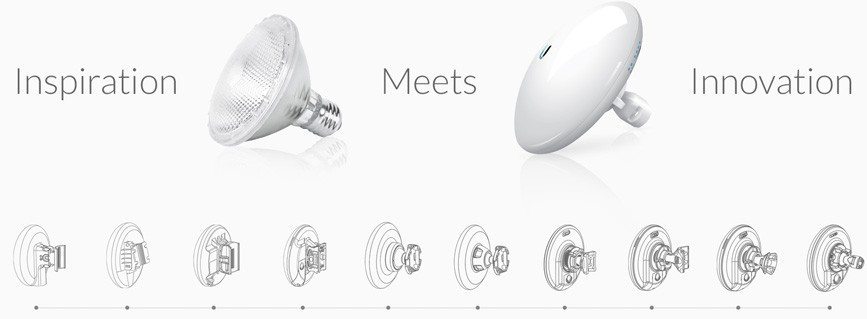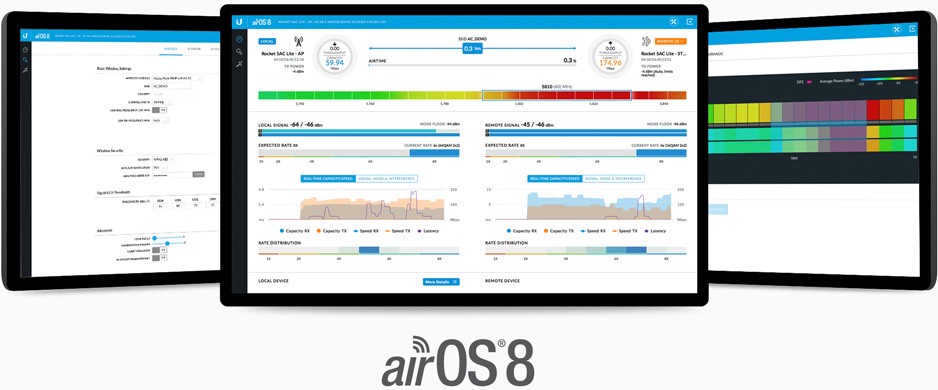Compact, UISP-ready, 2.4 GHz WiFi radio that can serve as a point-to-multipoint station.
The airMAX NanoBeam 2AC is a compact and high-performance wireless network bridge developed by Ubiquiti Networks, designed to provide an efficient and reliable solution for high-speed, long-distance wireless connectivity. As part of Ubiquiti's renowned airMAX series, the NanoBeam 2AC specifically targets applications that require robust point-to-point (PtP) or point-to-multipoint (PtMP) connections within the 2.4 GHz frequency band, leveraging advanced technology to overcome the challenges of interference and 15+ km distance.

The NanoBeam 2AC excels when paired with other airMAX ac devices, facilitating robust and high-throughput point-to-point (PtP) and point-to-multipoint (PtMP) configurations. This includes compatibility with airMAX ac base stations and sector antennas, which, when combined with the NanoBeam 2AC's directional connectivity, can significantly extend the range and quality of wireless broadband services. Moreover, this model operates exclusively within the 2.4 GHz band, it is important to pair it with devices that can communicate within this spectrum for effective interoperability. This consideration is crucial when designing a network to avoid compatibility issues with devices operating on different frequency bands.
In addition, please keep in mind that NanoBeam 2AC is designed to work seamlessly with devices within the airMAX series, integration with other Ubiquiti series, such as UniFi, might not be as straightforward. The UniFi series operates on a different management platform and is tailored towards managed indoor and semi-outdoor Wi-Fi networks, which could limit direct interoperability with airMAX devices focused on outdoor, long-range connectivity.
At the heart of the NanoBeam 2AC's performance is Ubiquiti's proprietary airMAX ac technology. This technology incorporates a patented Time Division Multiple Access (TDMA) protocol, which significantly enhances network throughput and latency by effectively managing network access times and reducing collisions. This is particularly advantageous in densely populated areas where the wireless spectrum is congested, allowing the NanoBeam 2AC to deliver high-quality connectivity with minimal interference.

Ubiquiti’s airMAX® technology is proven in millions of deployments worldwide, exhibiting outstanding performance in outdoor environments. The TDMA airMAX protocol with custom IC dramatically enables unprecedented scalability, high throughput and low latency in unlicensed, multipoint networks. While custom silicon provides hardware acceleration capabilities to the airMAX scheduler, to support the high data rates and dense modulation used in airMAX ac technology.

One of the standout features of the NBE-2AC-13 is its compact, all-in-one design, incorporating a high-gain, 13dBi antenna. This integrated antenna is highly directional, focusing the wireless signal to improve range and reduce noise, making it ideal for establishing focused wireless links over 15 km distances.
Constructed to withstand the rigors of outdoor deployment, the NanoBeam 2AC features a durable, weather-resistant housing. This ensures continued operation in a wide range of environmental conditions, from intense sunlight and heat to rain and cold (from -40 °C to 70 °C), protecting the internal components and maintaining the device's performance over time. Meanwhile, its compact form factor and lightweight design allow for easy mounting on a variety of surfaces, ensuring flexible deployment options like poles or walls, and offers the freedom of three-axis alignment. No screws are required for pole-mounting, and only a single wall screw (not included) is required for wall-mounting.
The NanoBeam 2AC is powered and configured via Power over Ethernet (PoE), which simplifies deployment by allowing the use of a single cable for both power supply and data transmission. This feature reduces the complexity of installation and enables flexible placement options to optimize signal strength and coverage.
Security features within airOS, including WPA2 encryption, ensure that communications over the NanoBeam 2AC are protected against unauthorized access, safeguarding the network and its data. Additionally, airOS supports Ubiquiti's airView spectrum analyzer tool, which allows for real-time identification of noise signatures and helps in choosing the best channel for network operation, further enhancing the device's performance in crowded wireless environments.
Powered by Ubiquiti's airOS 8, the NanoBeam 2AC offers an intuitive, user-friendly interface for device configuration and network management. airOS 8 provides advanced features such as device discovery, signal strength visualization, and network analytics, enabling network administrators to fine-tune settings for optimal performance. The operating system also supports airView, a real-time spectrum analysis tool that helps users identify the best channel for their network setup, reducing potential interference.
The airMAX NanoBeam 2AC from Ubiquiti Networks is adept at addressing a wide range of wireless connectivity needs. It's ideal for connecting two distant locations, the NanoBeam 2AC excels in creating high-speed, reliable PtP links. Whether it's connecting two buildings within a corporate campus, linking remote offices to the main network infrastructure, or extending internet access to a remote home or facility, this device ensures efficient, high-bandwidth connectivity over kilometers. While, in scenarios where a single internet source needs to be distributed to multiple locations, the NanoBeam 2AC serves as an effective CPE (Customer Premises Equipment). ISPs can deploy these units to deliver broadband services to residential or business customers spread over a wide area, ensuring consistent, high-quality internet access. Wireless ISP (WISP) Infrastructure can truly benefit from leveraging this model to expand their service coverage or enhance network capacity. Organizations can also deploy the NanoBeam 2AC as a cost-effective backup solution to ensure continuous internet connectivity. In the event of a primary connection failure, the device can maintain critical online operations, minimizing downtime and supporting business continuity.
For surveillance networks that span large areas, such as industrial complexes, parking lots, or public parks, the NanoBeam 2AC can provide the necessary backhaul links. It supports the high data rates required for transmitting high-definition video feeds from surveillance cameras back to a central monitoring location, maintaining the integrity and quality of the video data. Meanwhile, for temporary events like festivals, outdoor concerts, or sports competitions, the NanoBeam 2AC can quickly establish wireless links to provide internet access or connect various operational areas.
In each of these scenarios, the airMAX NanoBeam 2AC (NBE-2AC-13) by Ubiquiti Networks represents a sophisticated solution for establishing high-speed wireless connections over long distances. Combining a powerful airMAX ac engine with a high-gain directional antenna and a durable, weather-resistant design, the NanoBeam 2AC is engineered to deliver reliable, efficient connectivity for a wide range of applications, from connecting remote locations to extending network coverage in challenging environments.
Compare with similar products
| | | | |
|---|
| Wireless Standard | |
| |
| 802.11ac
| 802.11ac
| 802.11a/n
|
| 2.4GHz Radio Rate | |
| |
| 300 Mbps
|
|
|
| 5GHz Radio Rate | |
| |
| 450 Mbps
| 150 Mbps
|
| Wireless Antenna Frequency Range & Gain | |
| |
| 2.412 - 2.472 (GHz) 13 (dBi)
| 5.150 - 5.875 (GHz) 19 (dBi)
| 5.150 - 5.875 (GHz) 16 (dBi)
|
| Ethernet Ports | |
| |
| 1 x 1 Gbps
| 2 x 1 Gbps
| 1 x 100 Mbps
|
| Chipset | |
| |
| Atheros MIPS 74Kc, 533 MHz
| Atheros MIPS 74Kc, 720 MHz
| Atheros MIPS 74Kc, 560 MHz
|
| RAM | |
| |
| 64 MB
| 128 MB
| 64 MB
|
| Storage Memory | |
| |
| 8 MB
| 8 MB
|
| Operating Temperature | |
| |
| -40 °C to 70 °C
| -40 °C to 80 °C
| -40 °C to 70 °C
|
| Max Power Consumption | |
| |
| 7.5W
| 8.5 W
| 6 W
|
| Weight | |
| |
| 0.530 kg
| 0.530 kg
| 0.320 kg
|
| | | | |
|---|
| Wireless Standard | 802.11ac
| 802.11ac
| 802.11a/n
|
| 2.4GHz Radio Rate | 300 Mbps
|
|
|
| 5GHz Radio Rate |
| 450 Mbps
| 150 Mbps
|
| Wireless Antenna Frequency Range & Gain | 2.412 - 2.472 (GHz) 13 (dBi)
| 5.150 - 5.875 (GHz) 19 (dBi)
| 5.150 - 5.875 (GHz) 16 (dBi)
|
| Ethernet Ports | 1 x 1 Gbps
| 2 x 1 Gbps
| 1 x 100 Mbps
|
| Chipset | Atheros MIPS 74Kc, 533 MHz
| Atheros MIPS 74Kc, 720 MHz
| Atheros MIPS 74Kc, 560 MHz
|
| RAM | 64 MB
| 128 MB
| 64 MB
|
| Storage Memory |
| 8 MB
| 8 MB
|
| Operating Temperature | -40 °C to 70 °C
| -40 °C to 80 °C
| -40 °C to 70 °C
|
| Max Power Consumption | 7.5W
| 8.5 W
| 6 W
|
| Weight | 0.530 kg
| 0.530 kg
| 0.320 kg
|
Technical Specs / Datasheet





Reviews and ratings
Product rating